西方文化导论——文艺复兴
- 格式:ppt
- 大小:1.69 MB
- 文档页数:51

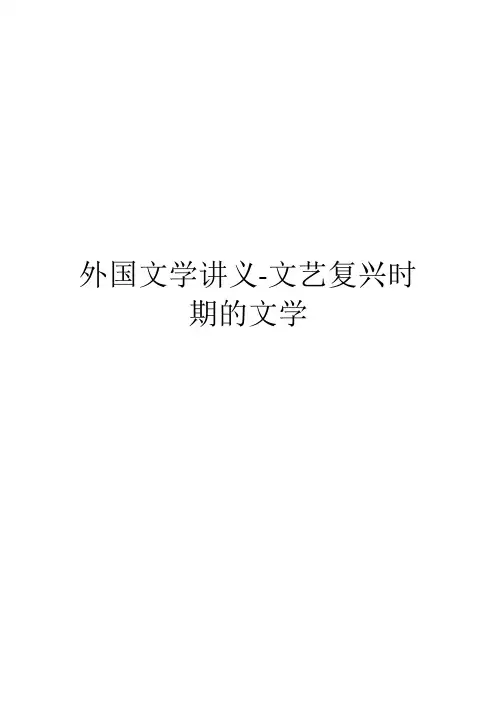
外国文学讲义-文艺复兴时期的文学第一节概述一、“文艺复兴”与“人文主义”1、文艺复兴:十四世纪到十六世纪在欧洲兴起的一场以新兴资产阶级人文主义为指导思想的反封建、反教会神权的思想解放运动。
最初兴起于意大利,逐渐扩大到法、德、英、荷、西班牙等其它欧洲国家。
2、人文主义(Humanism)又称人本主义、人道主义,是文艺复兴时期形成的资产阶级世界观,是与神学世界观相对立的世俗世界观。
其基本内容是:提倡以人为中心,反对以神为中心;提倡个性解放,反对禁欲主义;提倡现世的积极享乐,反对为来世的苦修行,认为“幸福在人间”;提倡自由平等,反对封建等级制度;提倡科学研究,崇尚理性,反对蒙昧主义,提出“知识就是力量”的口号。
这一切贯穿着一个总精神,即提倡人权,反对神权;提倡人性,反对神性;提倡人道,反对神道。
思想的核心是个性解放,个性自由。
人文主义文学是这一时期文学的主流。
二、“文艺复兴”在各国的特征意大利:诗歌、音乐、绘画、雕刻有突出成就,产生了诗人但丁、作家薄伽丘、画家达芬奇、拉斐尔、雕塑家米开朗琪罗、音乐家拉索等;A、彼特拉克:抒情诗人,第一个人文主义者。
代表作是抒情诗集《歌集》,献给恋人劳拉的诗。
袒露内心真挚的情感,大胆而直率。
B、薄迦丘:惊世骇俗之作——短篇小说集《十日谈》,被誉为“人曲”。
英国:诗歌、戏剧达到空前繁荣,有乔叟《坎特伯雷故事集》、托马斯•莫尔《乌托邦》、斯宾塞《仙后》、“大学才子派”的剧作、莎士比亚的创作。
西班牙:流浪汉小说《小癞子》、塞万提斯《堂吉诃德》、维伽《羊泉村》法国:表现为自由思想和怀疑思想的流行,有“七星诗社”、蒙田的《随笔集》、弗朗索瓦•拉伯雷《巨人传》成就较高。
第二节塞万提斯《堂吉诃德》一、生平和创作塞万提斯(1547——1616)是西班牙文艺复兴时期最伟大的现实主义作家。
他一生坎坷,饱受痛苦。
曾经参加西土战争并因伤致残失去左手,还在土耳其人的监狱中度过了五年牢狱生活。
回国后过着穷困潦倒的生活,几次遭人诬陷而入狱,在狱中开始构思《堂吉诃德》。
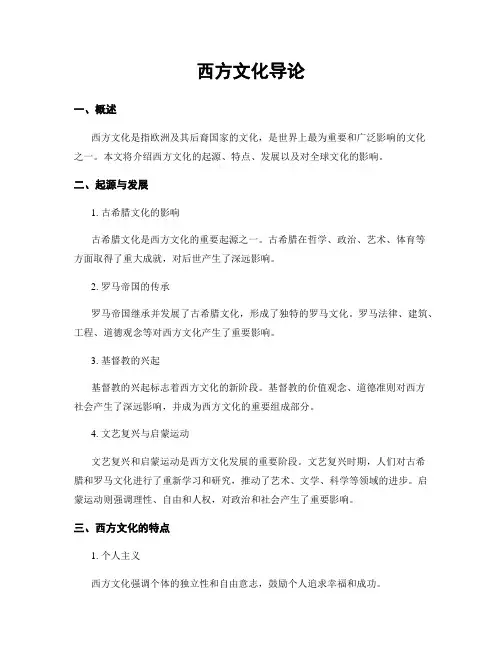
西方文化导论一、概述西方文化是指欧洲及其后裔国家的文化,是世界上最为重要和广泛影响的文化之一。
本文将介绍西方文化的起源、特点、发展以及对全球文化的影响。
二、起源与发展1. 古希腊文化的影响古希腊文化是西方文化的重要起源之一。
古希腊在哲学、政治、艺术、体育等方面取得了重大成就,对后世产生了深远影响。
2. 罗马帝国的传承罗马帝国继承并发展了古希腊文化,形成了独特的罗马文化。
罗马法律、建筑、工程、道德观念等对西方文化产生了重要影响。
3. 基督教的兴起基督教的兴起标志着西方文化的新阶段。
基督教的价值观念、道德准则对西方社会产生了深远影响,并成为西方文化的重要组成部分。
4. 文艺复兴与启蒙运动文艺复兴和启蒙运动是西方文化发展的重要阶段。
文艺复兴时期,人们对古希腊和罗马文化进行了重新学习和研究,推动了艺术、文学、科学等领域的进步。
启蒙运动则强调理性、自由和人权,对政治和社会产生了重要影响。
三、西方文化的特点1. 个人主义西方文化强调个体的独立性和自由意志,鼓励个人追求幸福和成功。
2. 科学与技术的重视西方文化崇尚科学与技术的发展,注重实证主义和理性思维,推动了现代科学的进步。
3. 民主与法治西方文化倡导民主政治和法治社会,注重个人权利和平等,推动了现代民主制度的发展。
4. 艺术与文学的创新西方文化在艺术与文学领域具有创新精神,不断探索新的表达形式和艺术风格。
四、西方文化对全球的影响1. 语言和文学英语作为西方文化的代表语言,成为国际交流和商务的重要工具。
西方文学作品如莎士比亚的戏剧、浪漫主义文学等对全球文学产生了深远影响。
2. 科学与技术西方文化的科学与技术成果对全球产生了广泛影响,如工业革命、电子技术、计算机科学等。
3. 政治与法律西方文化的民主制度和法治观念对全球政治和法律体系的发展产生了重要影响。
4. 艺术与娱乐西方音乐、电影、时尚等艺术与娱乐形式在全球范围内受到广泛欢迎,成为全球流行文化的一部分。
五、结论西方文化作为世界上最重要和广泛影响的文化之一,其起源、发展、特点以及对全球的影响都具有重要意义。

文艺复兴知识点文艺复兴是指发生在15世纪末至17世纪初的欧洲一系列文化和艺术变革的运动。
它标志着中世纪的结束和现代时代的开始。
文艺复兴涵盖了艺术、文学、科学和哲学等领域的重大变革,对欧洲乃至整个世界的文化发展产生了深远影响。
本文将介绍文艺复兴的主要知识点,包括其起源、特点、代表人物以及对艺术和科学的影响。
一、起源文艺复兴起源于意大利,并逐渐传播到欧洲其他地区。
在14世纪末,意大利的城市国家开始繁荣起来,商业和金融活动的兴起带来了人们对自由和个人权利的追求。
同时,古希腊和古罗马的文化遗产也逐渐被重新发现和重视。
这种对古典文化的热爱和对世俗主义的推崇成为文艺复兴的基石。
二、特点1. 人文主义:人文主义是文艺复兴的核心思想。
它强调人的尊严和价值,追求人的全面发展。
人文主义者研究古代文化,关注人类的能力和潜力,提倡人的自由和个性的发展。
他们反对教条主义和追随权威,主张人们应该通过理性思考来认识世界。
2. 艺术的重视:文艺复兴时期的艺术家们对艺术的追求达到了前所未有的高度。
他们追求真实和自然的表现方式,注重透视和光影效果的运用。
文艺复兴的绘画作品以人体为中心,追求人体的比例和解剖学的准确性。
著名艺术家达·芬奇和米开朗基罗就是文艺复兴时期的代表人物。
3. 科学的进步:文艺复兴时期的科学家们对自然界的研究也取得了重大突破。
他们通过观察和实验,提出了一系列新的科学理论和发现。
尼古拉·哥白尼提出了地心说的观点,开创了现代天文学;伽利略·伽利莱通过望远镜的观察,证实了地球围绕太阳运转的理论。
三、代表人物1. 达·芬奇(Leonardo da Vinci):达·芬奇是文艺复兴时期最具代表性的艺术家之一。
他是一位画家、雕塑家、建筑师、发明家和科学家。
他的作品《蒙娜丽莎》和《最后的晚餐》等至今仍然被誉为艺术的杰作。
2. 米开朗基罗(Michelangelo):米开朗基罗是文艺复兴时期最伟大的雕塑家和画家之一。
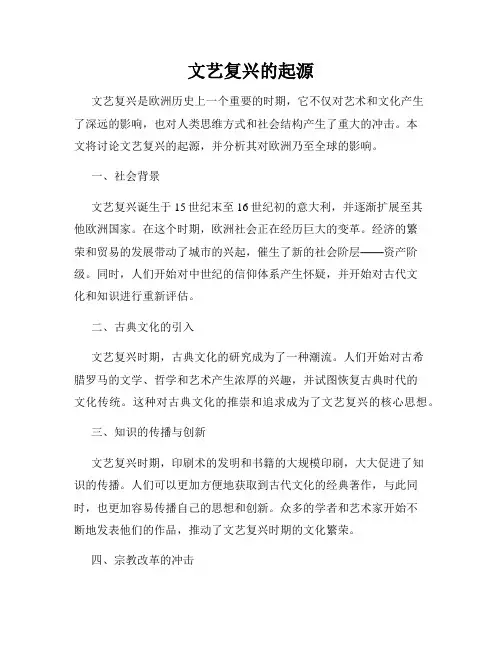
文艺复兴的起源文艺复兴是欧洲历史上一个重要的时期,它不仅对艺术和文化产生了深远的影响,也对人类思维方式和社会结构产生了重大的冲击。
本文将讨论文艺复兴的起源,并分析其对欧洲乃至全球的影响。
一、社会背景文艺复兴诞生于15世纪末至16世纪初的意大利,并逐渐扩展至其他欧洲国家。
在这个时期,欧洲社会正在经历巨大的变革。
经济的繁荣和贸易的发展带动了城市的兴起,催生了新的社会阶层——资产阶级。
同时,人们开始对中世纪的信仰体系产生怀疑,并开始对古代文化和知识进行重新评估。
二、古典文化的引入文艺复兴时期,古典文化的研究成为了一种潮流。
人们开始对古希腊罗马的文学、哲学和艺术产生浓厚的兴趣,并试图恢复古典时代的文化传统。
这种对古典文化的推崇和追求成为了文艺复兴的核心思想。
三、知识的传播与创新文艺复兴时期,印刷术的发明和书籍的大规模印刷,大大促进了知识的传播。
人们可以更加方便地获取到古代文化的经典著作,与此同时,也更加容易传播自己的思想和创新。
众多的学者和艺术家开始不断地发表他们的作品,推动了文艺复兴时期的文化繁荣。
四、宗教改革的冲击文艺复兴同样受到了宗教改革的冲击。
早期的宗教改革者如马丁·路德和约翰·加尔文提出了对教会教义和做法的质疑,引发了欧洲各地的宗教改革运动。
这些改革使得人们对宗教权威的盲从开始动摇,同时也对宗教艺术和教会的文化产生了重大影响。
五、对艺术的影响文艺复兴对艺术的影响是巨大的。
在这个时期,艺术家追求真实、理性和人文主义的思想,艺术作品更加注重人体的形象和自然的再现。
例如,达·芬奇的《蒙娜丽莎》和米开朗基罗的《大卫》等作品,都体现了文艺复兴时期对人体构造和美学的独特追求。
六、对思维方式的影响文艺复兴对人类思维方式的影响同样不可忽视。
文艺复兴时期的人们强调人类自身的价值和能力,开始关注个体的意识和自由。
这种思想倾向为近代启蒙运动的兴起提供了基础,同时也为人类社会的进步和发展奠定了思想基础。

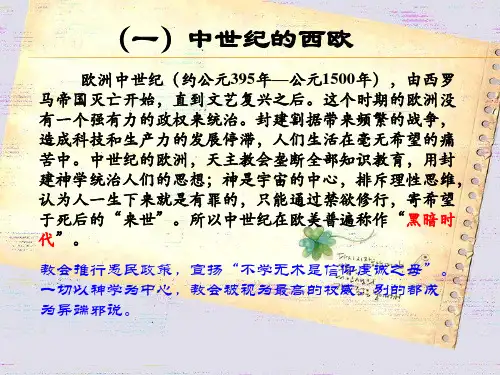
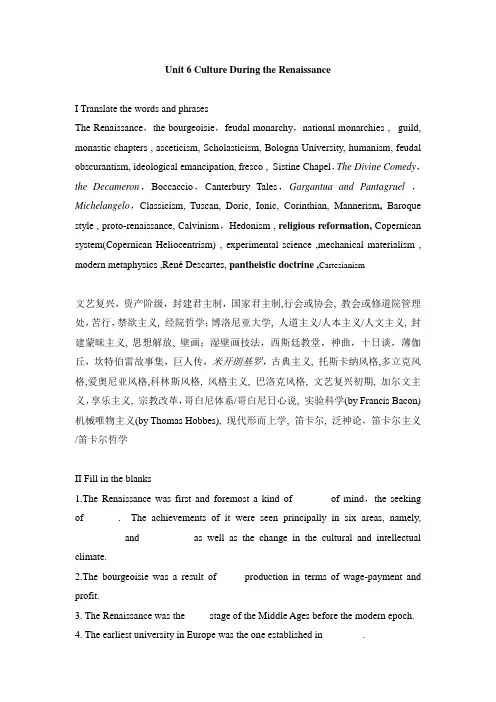
Unit 6 Culture During the RenaissanceI Translate the words and phrasesThe Renaissance,the bourgeoisie,feudal monarchy,national monarchies ,guild, monastic chapters , asceticism, Scholasticism,Bologna University, humanism, feudal obscurantism, ideological emancipation,fresco ,Sistine Chapel,The Divine Comedy,the Decameron,Boccaccio,Canterbury Tales,Gargantua and Pantagruel ,Michelangelo,Classicism,Tuscan, Doric, Ionic, Corinthian, Mannerism,Baroque style , proto-renaissance, Calvinism,Hedonism , religious reformation, Copernican system(Copernican Heliocentrism) , experimental science ,mechanical materialism , modern metaphysics ,René Descartes, pantheistic doctrine ,Cartesianism文艺复兴,资产阶级,封建君主制,国家君主制,行会或协会, 教会或修道院管理处,苦行,禁欲主义, 经院哲学;博洛尼亚大学, 人道主义/人本主义/人文主义,封建蒙昧主义,思想解放, 壁画;湿壁画技法,西斯廷教堂,神曲,十日谈,薄伽丘,坎特伯雷故事集,巨人传,米开朗基罗,古典主义, 托斯卡纳风格,多立克风格,爱奥尼亚风格,科林斯风格, 风格主义, 巴洛克风格, 文艺复兴初期, 加尔文主义,享乐主义, 宗教改革,哥白尼体系/哥白尼日心说, 实验科学(by Francis Bacon)机械唯物主义(by Thomas Hobbes), 现代形而上学, 笛卡尔, 泛神论,笛卡尔主义/笛卡尔哲学II Fill in the blanks1.The Renaissance was first and foremost a kind of _______of mind,the seeking of_______.The achievements of it were seen principally in six areas, namely, __________and __________as well as the change in the cultural and intellectual climate.2.The bourgeoisie was a result of ____ production in terms of wage-payment and profit.3. The Renaissance was the ____ stage of the Middle Ages before the modern epoch.4. The earliest university in Europe was the one established in _______ .5. The medieval civilization met its climax during the _________ century.6. The Renaissance first emerged in the city of _______in Italy before it made its way to Milan,Venice and Naples. Then it spread to France,Spain,Germany and England.7. The Renaissance is characterised by seeking________, _______and political awareness, based on cultural production and religious reformation.8. Humanism perhaps began in ______and its most famous predecessors were men like ______and Petrarch.9.The core idea of the Renaissance was _____.10.The major boost of Humanism is _______ .11. The Renaissance was to recover ancient _______ ; while the Religious Reformation was to recover ancient ________ .12. With far-reaching political, economic and social effects, the Reformation becamea basis for the founding of_______ , which emerged as one of the three major branches of Christianity.13. _______was the founder of experimental science and materialism.14. Martin Luther developed the idea of justification by faith and attacked the sale of indulgences by Tetzel from the Vatican Church by _______at Wittenberg15. Five dominant types of architecture during the Renaissance are__________, and Composite.16.Francis Bacon was the founder of _____ and _____.17._____ established mechanical materialism. .18. “I am thinking, therefore I exist” was spoken by _____. He also provided the mechanistic method of reasoning called _______. .1. emancipation, intellectual freedom, painting, sculpture, poetry, fiction, drama, religious reformation ;2. mass3. last4. Bologna5. 13th6. Florence7. ideological emancipation, intellectual freedom 8. Italy, Dante 9. Humanism10. the fall of Constantinople 11. culture and art, Christian theology 12. Protestantism 13. Francis Bacon 14. nailing his famous 95 theses on the church door15.Tuscan, Doric, Ionic, Corinthian 16. experimental science, materialism17. Thomas Hobbes, 18. René Descartes,CartesianismIII Answer the questions:1. What factors contributed to the emergence of the Renaissance?the break-up of feudal structures; the strengthening of city-states in Italy; the emergence of national monarchies in Spain, France, and England; the thrive of many different kinds of social structures; the rise of folk culture and popular literature in most European countries; changes in secular education, particularly the founding of universities.2. What are the major features of the Renaissance ?Feature: The Renaissance is characterised by seeking ideological emancipation, intellectual freedom and political awareness, based on cultural production and religious reformation. All these were undertaken or unfolded gradually but widely, extending its influences to every corner of Europe, with more and more people getting involved. The most striking feature of the Renaissance was doubtlessly the flourish of humanism.3. What are the reasons for the emergence of the Renaissance in Italy?(1) Italy’s prosperous trade and production of handicraft, which furnished a material basis for cultural development(2) its rich variety of urban social life coinciding with the emergence of more cities where manufacturing and commercial activities called for the vigorous development of cultural life(3) the wealth of culture passed down from the artistic and architectural heritage of Rome(4) the use of Latin as a common language in the Italian society, which helped to retain a good memory of classical culture4. What are the main demands of humanism?a. literature should represent the feelings of ordinary humans;b. science should produce benefits for mankind;c. education should develop individual personality and free human feelings and intelligence from divine bondage;d. man should become central in everything;e. human right should be against divine right, human nature against divine nature, and individuality against medieval religious bondage.4Please match the following artists and writers with their representative works.Please match the following scientists with their great achievement.5.Please introduce William Shakespeare, the most accomplished writer during the Renaissance, and his great works.William Shakespearewas an English poet and playwright, widely regarded as the greatest writer in the English language and the world’s pre -eminent dramatist. He is often called England’s national poet and the “Bard of Avon”. His surviving work s, including some collaborations, consist of about 38 plays, 154 sonnets, two long narrative poems, and several other poems. His plays have been translated into everymajor living language and are performed more often than those ofany other playwright.His writing career falls into three phases. His early phase coincided with the reign of Queen Elizabeth I, marking the ascent of capitalist development. The major works he wrote in this period include A Mid-Summer Night’s Dream and Twelfth Night .The 2nd phase occurred in a period when political conflicts and contradictions were intensified between the feudal forces headed by the royal family on one side and the newly emerging capitalist forces and the ordinary people on the other. Most of his writings during the period were tragedies, embracing Hamlet, Othello, King Lear, Macbeth and Anthony and Cleopatra.The 3rd phase focused on the writing of plays related to myths, such as The Winter’s Tale and The Tempest. Shakespeare’s success came from his understanding of historical, social and intellectual circumstances of England, based on his humanist values and pursuit and represented by a large number of impressive characters with a strong sense of individual identity.6. Please analyze the features of classicism.a. Drama and other forms of arts tended to imitate and reflect those of the Graeco-Roman civilization.b. Literature of this period is termed neoclassical, because it sought beauty of form rather than the content.c. Culture in this period not only exhibited the productions of artistic works, but promoted the development of life styles, such as dress and speech.d. As commonly opposed to Romanticism, the 17th-century classicism in France implies a social ideal.e. Classicism tends naturally to be expressed by the adoption of certain classical forms.IV True or False Questions.(1) Individualism was the foundation of social ideology during the Renaissance.(2) Dante’s most important works On Monarchy shows most of his humanist ideas over which he was meditating during years of exile.(3) Petrarch opposed the papal authority and other supreme authorities by exemplifying his attitudes towards Aristotle.(4) The Renaissance and humanism greatly contributed to the occurrence of Enlightenment and bourgeois revolution.(5) Humanism helped spark the Reformation, while the latter hindered thedevelopment of the former.(TFTTT)题源:1. The bourgeoisie was a result of ____ production in terms of wage-payment and profit.A. massB. agriculturalC. industrialD. Commercial2. The Renaissance was the ____ stage of the Middle Ages before the modern epoch.A. transitionalB. lastC. initialD. preparatory3. The earliest university in Europe was the one established in _______ .A. BerlinB. RomeC. BolognaD. Oxford4. The medieval civilization met its climax during the _________.A. 14th centuryB. 13th centuryC. 12th centuryD. 11th century5. Which of the following is not the inspiration for the Renaissance?A. The break-up of feudal structures.B. The emergence of national monarchies.C. The rise of folk culture and popular literature.D. The revival of religious beliefs.6.Which of the following is not the major principle of humanism?A. Literature should represent the feelings of ordinary humans.B. Science should produce benefits for mankind.C. Education should develop divine spirit and classical culture.D. Man should become central in everything.7.The Renaissance made its first appearance in the city of _______ .A. VeniceB. ParisC. FlorenceD. London8.The core idea of the Renaissance was _____A. rationalismB. realismC. humanismD. classicism9.The major boost of Humanism is _______ .A. the fall of ConstantinopleB. the prosperity of the city of FlorenceC. the prosperous trade and production of handicraftD. the rich variety of urban social life10.The most important reason for the emergence of the Renaissance in Italy is _______ .A. Italy’s prosperous tradeB. the variety of urban social lifeC. the use of Latin as a common languageD. that the newly emerging capitalists sought to oppose feudal and divine dominance of society文艺复兴时期各领域代表人物及其代表作Representatives and their representative works in the Renaissance高乃依拉辛莫里哀Fill in the blanks:1.______was considered to be the founder of Renaissance painting in Italy.2.Five dominant types of architecture during the Renaissance: ___________.3.Translate1)Mannerism 2) Polyphonic music 3) proto-renaissance4) Hedonism 5) Calvinism 6) The Theory of Predestination7) Pendulum 8) Copernican system 9) classicism。
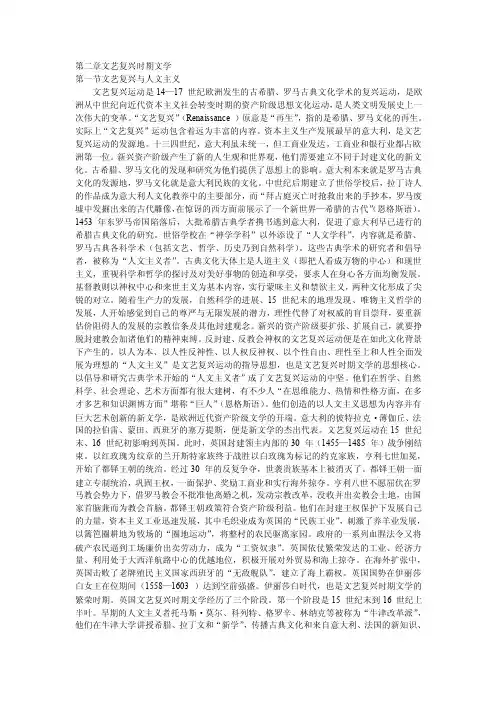
第二章文艺复兴时期文学第一节文艺复兴与人文主义文艺复兴运动是14—17 世纪欧洲发生的古希腊、罗马古典文化学术的复兴运动,是欧洲从中世纪向近代资本主义社会转变时期的资产阶级思想文化运动,是人类文明发展史上一次伟大的变革。
“文艺复兴”(Renaissance )原意是“再生”,指的是希腊、罗马文化的再生。
实际上“文艺复兴”运动包含着远为丰富的内容。
资本主义生产发展最早的意大利,是文艺复兴运动的发源地。
十三四世纪,意大利虽未统一,但工商业发达,工商业和银行业都占欧洲第一位。
新兴资产阶级产生了新的人生观和世界观,他们需要建立不同于封建文化的新文化。
古希腊、罗马文化的发现和研究为他们提供了思想上的影响。
意大利本来就是罗马古典文化的发源地,罗马文化就是意大利民族的文化。
中世纪后期建立了世俗学校后,拉丁诗人的作品成为意大利人文化教养中的主要部分,而“拜占庭灭亡时抢救出来的手抄本,罗马废墟中发掘出来的古代雕像,在惊讶的西方面前展示了一个新世界—希腊的古代”(恩格斯语)。
1453 年东罗马帝国陷落后,大批希腊古典学者携书逃到意大利,促进了意大利早已进行的希腊古典文化的研究。
世俗学校在“神学学科”以外添设了“人文学科”,内容就是希腊、罗马古典各科学术(包括文艺、哲学、历史乃到自然科学)。
这些古典学术的研究者和倡导者,被称为“人文主义者”。
古典文化大体上是人道主义(即把人看成万物的中心)和现世主义,重视科学和哲学的探讨及对美好事物的创造和享受,要求人在身心各方面均衡发展。
基督教则以神权中心和来世主义为基本内容,实行蒙昧主义和禁欲主义,两种文化形成了尖锐的对立。
随着生产力的发展,自然科学的进展、15 世纪末的地理发现、唯物主义哲学的发展,人开始感觉到自己的尊严与无限发展的潜力,理性代替了对权威的盲目崇拜,要重新估价阻碍人的发展的宗教信条及其他封建观念。
新兴的资产阶级要扩张、扩展自己,就要挣脱封建教会加诸他们的精神束缚。

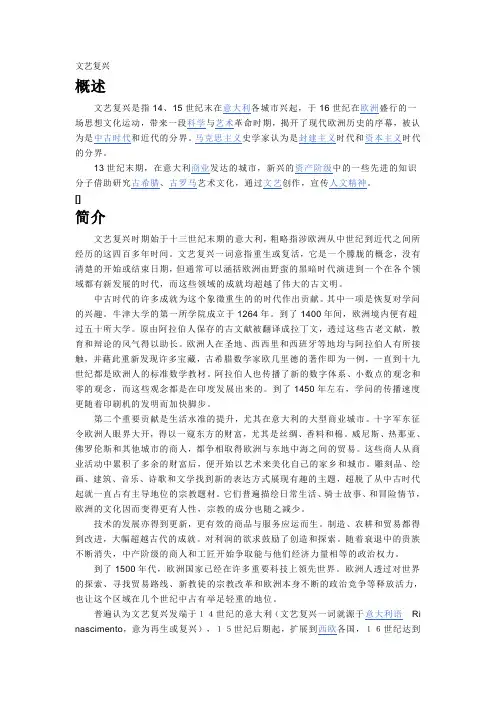
文艺复兴概述文艺复兴是指14、15世纪末在意大利各城市兴起,于16世纪在欧洲盛行的一场思想文化运动,带来一段科学与艺术革命时期,揭开了现代欧洲历史的序幕,被认为是中古时代和近代的分界。
马克思主义史学家认为是封建主义时代和资本主义时代的分界。
13世纪末期,在意大利商业发达的城市,新兴的资产阶级中的一些先进的知识分子借助研究古希腊、古罗马艺术文化,通过文艺创作,宣传人文精神。
[]简介文艺复兴时期始于十三世纪末期的意大利,粗略指涉欧洲从中世纪到近代之间所经历的这四百多年时间。
文艺复兴一词意指重生或复活,它是一个朦胧的概念,没有清楚的开始或结束日期,但通常可以涵括欧洲由野蛮的黑暗时代演进到一个在各个领域都有新发展的时代,而这些领域的成就均超越了伟大的古文明。
中古时代的许多成就为这个象徵重生的的时代作出贡献。
其中一项是恢复对学问的兴趣。
牛津大学的第一所学院成立于1264年。
到了1400年间,欧洲境内便有超过五十所大学。
原由阿拉伯人保存的古文献被翻译成拉丁文,透过这些古老文献,教育和辩论的风气得以助长。
欧洲人在圣地、西西里和西班牙等地均与阿拉伯人有所接触,并藉此重新发现许多宝藏,古希腊数学家欧几里德的著作即为一例,一直到十九世纪都是欧洲人的标准数学教材。
阿拉伯人也传播了新的数字体系、小数点的观念和零的观念,而这些观念都是在印度发展出来的。
到了1450年左右,学问的传播速度更随着印刷机的发明而加快脚步。
第二个重要贡献是生活水准的提升,尤其在意大利的大型商业城市。
十字军东征令欧洲人眼界大开,得以一窥东方的财富,尤其是丝绸、香料和棉。
威尼斯、热那亚、佛罗伦斯和其他城市的商人,都争相取得欧洲与东地中海之间的贸易。
这些商人从商业活动中累积了多余的财富后,便开始以艺术来美化自己的家乡和城市。
雕刻品、绘画、建筑、音乐、诗歌和文学找到新的表达方式展现有趣的主题,超脱了从中古时代起就一直占有主导地位的宗教题材。
它们普遍描绘日常生活、骑士故事、和冒险情节,欧洲的文化因而变得更有人性,宗教的成分也随之减少。
历史九年级知识点文艺复兴文艺复兴是发生在欧洲历史上的一段重要时期,对于整个历史九年级的学习来说,文艺复兴是一个必须要掌握的知识点。
本文将围绕文艺复兴展开,通过对文艺复兴的定义、起源、主要特点以及对欧洲的影响等方面进行详细的介绍,以便同学们更好地理解和掌握这一知识点。
一、文艺复兴的定义文艺复兴(Renaissance),意为“重生”,起初只用来表示古典艺术再现,后来逐渐演变为人文主义的具体表现,包括哲学、文学、艺术等多个领域。
文艺复兴起源于14世纪末15世纪初的意大利,并逐渐扩散至欧洲其他地区。
二、文艺复兴的起源文艺复兴的起源地是意大利,这里集聚了许多重要的城市,如佛罗伦萨、威尼斯等。
意大利地理位置优越,接触到了古希腊、古罗马的文化遗产,激发了人们对古典文化的热爱。
同时,15世纪时,意大利经济繁荣,商业活动频繁,为艺术家们提供了良好的工作和生活条件,促进了文艺复兴的发展。
三、文艺复兴的主要特点1. 宗教改革:文艺复兴与宗教改革有着密切的联系,神学家马丁·路德的宗教改革运动使得西方基督教发生了深刻变革。
2. 人文主义:人文主义是文艺复兴的核心理念,强调人的价值,提倡对人文知识的追求与研究。
3. 新航海时代的开启:哥伦布的航海事业开拓了新大陆,欧洲的地理观念发生了巨大的变革。
4. 科学思维兴起:文艺复兴时期,以伽利略为代表的科学家们开始运用实验和观察来研究自然现象,形成了现代科学的雏形。
四、文艺复兴对欧洲的影响1. 艺术与文学:文艺复兴时期的艺术家们以达·芬奇为代表,开创了现代绘画的先河,并在文学方面创作了许多杰出的作品。
2. 人类思维方式的改变:文艺复兴时期的人文主义思想强调对人的重视,推动了人们从中世纪的宗教居中思想转向人类中心思想。
3. 文化的传播:随着文艺复兴的发展,人们之间的交流与合作变得更加频繁,文化得到了更为广泛的传播。
4. 社会结构的重构:文艺复兴为社会的重构提供了契机,以市民阶级为代表的新兴阶层得到了更多的权力和地位。
西方文艺复兴概述:西方文艺复兴是16世纪末17世纪初欧洲大规模艺术和文化复兴的总称。
它标志着欧洲从中世纪向现代的转型,富有创新,积极向外开放,进一步展示了人类视野的扩展和创造力的惊人力量。
本文从文化、科学、艺术、社会结构等角度来探讨西方文艺复兴。
一、文化西方文艺复兴的文化表现是关注人类中心主义,重新关注人类价值和个体优秀品质的思想。
文艺复兴时期意大利人主张“人文主义”,认为应以人文精神为中心,尊重人的自由、人的尊严,天国一定是在这个世界中。
于是,社会上出现了一种以人为本的思想,“文艺革命”波及欧洲,文化思潮由意大利扩散至欧洲各个国家。
二、科学西方文艺复兴时期是科学的重要发展时期。
这个时期的自然科学开始了一个新的历史时期,激重了16~17世纪以来的“科学革命”。
这段时期,自然科学在思想上和方法上与中世纪或其他欧洲文化之间的断裂发生了深刻变化。
文艺复兴时期的思想涵养,反思了中世纪关于世界观和现实的复杂系统,对现实的尝试引领了物理学、生物学和医学的超越。
文艺复兴时期的物理学家,如劳伦斯篮球场、加利略、爱因斯坦等,他们的大发现和形成具有崭新的思维模式和方法,对独立思考、发明创造方面也有很大启迪意义。
三、艺术文艺复兴时期的艺术是“经典”世界的新再现。
人们在这个时期集中注意从经典时期创作和制作艺术品的文化和美术理论,使得这些经典成为现代艺术的重要来源。
在文艺复兴时期,艺术重点在探索人性。
人的艺术描述变得更为准确、真实和感性。
文艺复兴时期的艺术涵养,引领当代世界美学的发展和接受,其心理定义和思维方式,对今天我们理解艺术达成美学观感有重要意义。
同时,艺术产品还引发社会人文色彩,催生全新的社会花朵和道德标准。
四、社会结构文艺复兴导致了欧洲社会的政治,经济和社会结构的重大变化。
文艺复兴时期的义务性感和人类主义思想对社会体制、社会制度,也带来了深刻的影响。
在文艺复兴年代,富有资本的中产阶级之间的分工已经开始产生。
废除了以前的封建主义,被民族主义文化取代,这样的文化特色更符合了一个新的市民经济发展方向。
历史中的文艺复兴知识点文艺复兴(Renaissance)是西方历史上的一个重要时期,从14世纪末至17世纪初,标志着欧洲从中世纪的黑暗时代进入现代文明的新阶段。
本文将介绍文艺复兴的起源、特征、重要人物和影响等知识点。
一、起源文艺复兴起源于意大利,特别是佛罗伦萨。
14世纪末,由于城市商业的繁荣、罗马古迹的重现以及古希腊和罗马文化的再度受到重视,人们开始对中世纪的僵化宗教观念感到不满,并倡导以人为中心、追求自由与个性发展的新思潮。
二、特征1. 人文主义:人文主义是文艺复兴的核心理念,强调个人才能和人的价值。
人文主义思想对古希腊罗马的学问进行了重新发掘,并将这些学问与基督教思想进行了融合。
2. 人体与透视的研究:文艺复兴时期,艺术家开始研究人体的解剖结构,追求真实的人体表现。
同时,对透视的研究也使得画面逼真,在绘画中呈现了立体感。
3. 文学创作:文艺复兴时期的文学作品,尤其是诗歌和戏剧,追求真实性和自由性。
著名的文艺复兴作家有但丁、莎士比亚等。
三、重要人物1. 达芬奇(Leonardo da Vinci):达芬奇是文艺复兴时期的杰出艺术家和科学家,他既是画家、雕塑家又是发明家。
他的代表作《蒙娜丽莎》和《最后的晚餐》被誉为世界艺术的巅峰之作。
2. 米开朗基罗(Michelangelo):米开朗基罗是文艺复兴时期的雕塑家和画家,代表作品有《大卫像》和梵蒂冈圣彼得大教堂的壁画《创世纪》等。
他对人体结构的研究和艺术创作具有重要影响。
3. 文森佐·贝利尼(Giovanni Bellini):贝利尼是意大利文艺复兴时期著名的画家,被誉为威尼斯画派的奠基人。
他的作品富有细腻的色彩和光影效果,对后世画家影响深远。
四、对欧洲的影响1. 艺术风格的变革:文艺复兴时期的艺术作品在形式上追求真实、逼真,技巧上更加精湛。
从中世纪追求神圣与超验的艺术风格转向对人类的关注和描述。
2. 科学和人文思想的进步:文艺复兴时期,科学家们开始对宇宙和人类进行更深入的研究,推动了科学思维的发展。